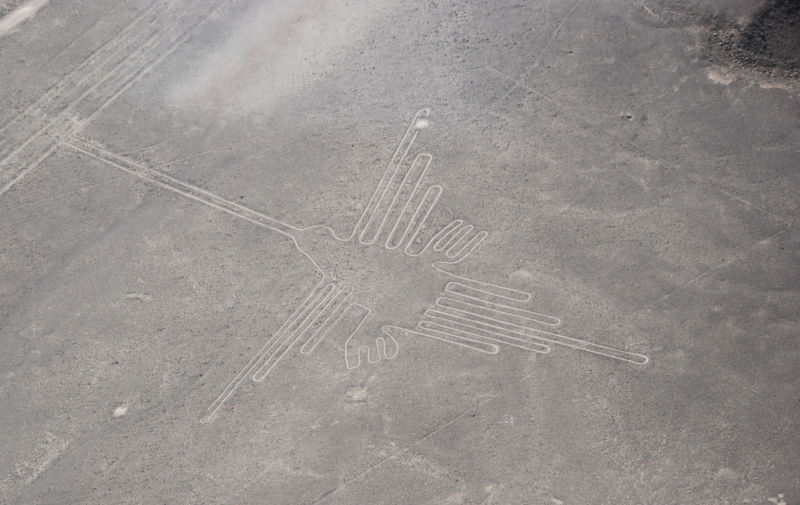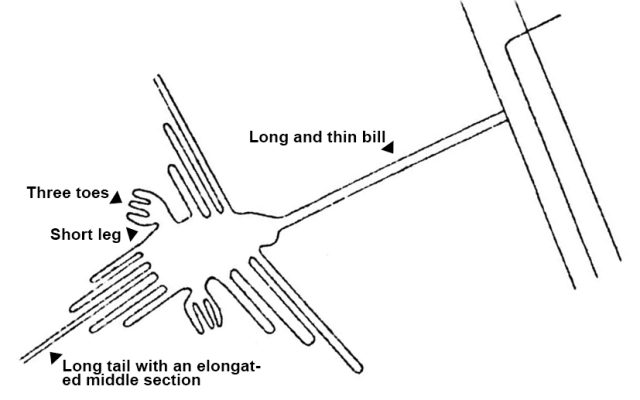
At first glance, one of the most famous figures of Peru’s Nasca Lines looks like a fairly generic hummingbird. But the details of the drawing—and those of several other ancient drawings, paintings, and sculptures of animals and plants around the world—reveal a lot of information about the actual species. The bird has three toes, all pointed in the same direction, a long, thin beak, and the feathers at the center of its tail are long and straight.
Those are trademarks of birds called hermits, a genus in the hummingbird family. Other hummingbird species in Peru have forked or fan-shaped tails (which is the kind of detail the Nasca artists likely would have gotten right).
“Until now, the birds in these drawings have been identified based on general impressions or a few morphological traits present in each figure,” said zooarchaeologist Masaki Eda of the Hokkaido University Museum and his colleagues in a statement. That team examined the hermit and 15 other bird geoglyphs in detail, noting the shapes and relative sizes of their beaks, heads, necks, bodies, wings, and feet. Like biologists trying to identify a new specimen in the field, the researchers compared those details to the birds that live in Peru today.
By looking at the Nasca Lines the way ornithologists would look at specimens, Eda and his colleagues managed to identify some particular species among the figures.
Two other bird geoglyphs, one of which had been previously identified as a guano bird (one of several species of seabirds that roost in large numbers on Peru’s coastal islands), turned out to likely be pelicans. Peruvian pelicans are one of three species of guano birds (along with the Peruvian booby and the Guanay cormorant) that populate Peru’s coast. They feast on oily anchovies and dump piles of nitrate-rich guano that, thanks to the desert climate, never wash away.
Guano
Guano—a word for bird poop that English actually owes to Peru’s Quechua-speaking indigenous people—is a valuable fertilizer. The Inca Empire protected and managed guano-bird populations, and the Spanish colonizers who arrived 500 years ago did the same. Under Inca rule and again under Spanish colonial rule, killing a guano bird or disturbing a nest carried a death sentence. Today, the Peruvian government carefully manages an annual guano harvest on certain coastal islands. Given the importance of guano, it’s easy to see why people at Nasca might have considered the pelican important enough to carve into the desert floor.
And that’s why Eda and his colleagues say their work matters. By identifying particular species in the Nasca lines, they may add a few more pieces to the enduring puzzle of why the ancient Nasca people built these monumental artworks, why they chose the shapes they did, and what the figures mean.

Masaki Eda
Hermits and pelicans offer a possible hint: neither species lives anywhere near Nasca today, and Eda and his colleagues say it’s unlikely that they did in the past. Hermits live in forests roughly 1,400km (900 miles) to the north, near the modern border with Peru, and to the east, on the far side of the Andes Mountains from Nasca. The coast, along with its Peruvian pelicans and piles of guano, lies roughly 80km (50 miles) from Nasca. “Our findings show they drew exotic birds, not local birds, and this could be a clue as to why they drew them in the first place,” said Eda in a statement.
But the team wasn’t able to identify all 16 birds. A few, which most archaeologists labeled condors or flamingos, stubbornly defied ornithological labels. Their detailed features didn’t match either condors or flamingos, according to Eda and his colleagues, but they didn’t match any other living Peruvian birds, either. It’s possible that those figures represent an extinct (or locally extinct) species—or perhaps they were just inaccurate drawings.
The bird geoglyphs are just 16 out of more than 300 enormous figures spread across 450 square kilometers (280 miles) near Nasca. Between 400 BCE and 1000 CE, Nasca people scraped away the surface layer of reddish iron-rich pebbles to expose the contrasting yellowish gray of the underlying soil to create outlines of animals, plants, and geometric shapes. Most of the figures show up best if you have a bird’s-eye view.
To better understand the Nasca birds, Eda and his colleagues plan to compare the Nasca images with birds drawn and painted on Nasca pottery from the same period, as well as bird remains excavated at the ruins of Nasca settlements. The work may shed light on not only the purpose of at least a few of the Nasca figures, but pre-Columbian ecosystems as well.
Journal of Archaeological Science: Reports, 2019. DOI: 10.1016/j.jasrep.2019.101875; (About DOIs).
Không có nhận xét nào:
Đăng nhận xét